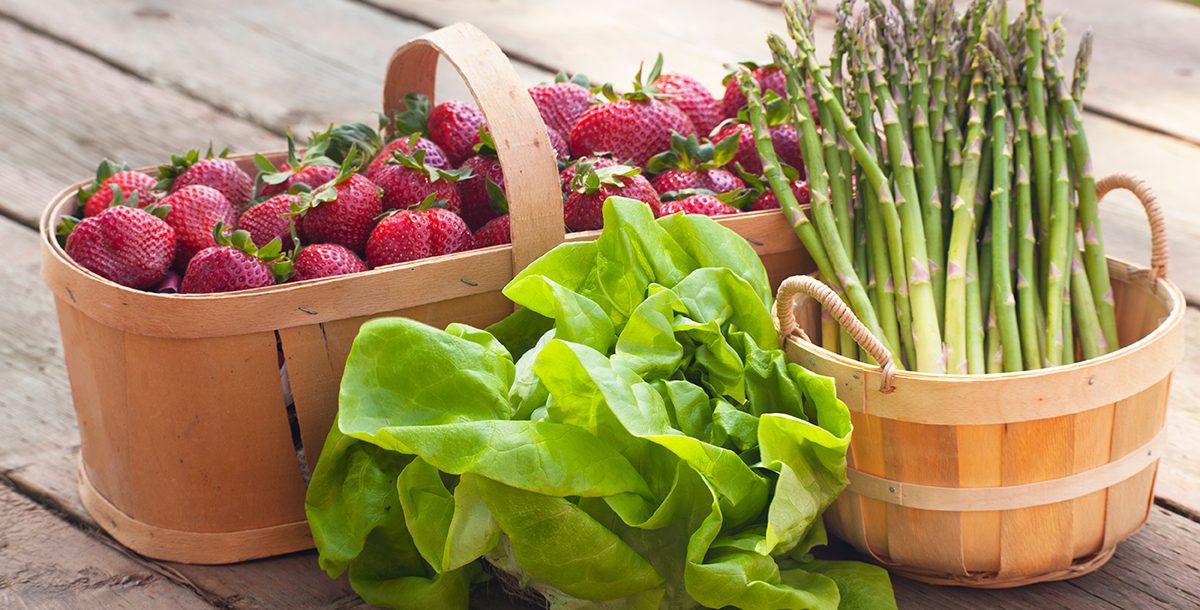Warmer weather means a variety of fresh, nutrient-packed spring fruits and vegetables are starting to become available at the local grocery store and the farmers market. Be sure to add some – or all – of these fresh, spring produce items to your next grocery list!
What are the best fruits to eat in spring?
Fruits and veggies can help your body get the vitamins and minerals it needs. For example, strawberries and cherries are spring fruits with great health benefits. In fact, one cup of sliced strawberries offers nearly 150 percent of your daily minimum vitamin C! And both make a great, ready-to-eat afternoon snack when you’re looking for a sweet bite.
Other fruits are in season each spring, including:
- Apples
- Apricots
- Bananas
- Grapefruit
- Lemons
- Limes
- Mangoes
- Pineapples
What vegetables are best in spring?
Asparagus, fava beans, root vegetables, snap peas and leafy greens are just a few in-season spring vegetables. These veggies are often great sources of nutrients, too. Asparagus alone provides vitamins A, C, E, K and fiber! Leeks also contain great sources of vitamins and the anti-inflammatory antioxidant, quercetin, which is important for heart health.
You’ll find vegetables that are typically in-season in the spring are often ones that can grow in colder climates, so they are ready during the spring months.
Some of the best in-season vegetables you can find in your store throughout springtime include:
- Artichokes
- Beets
- Broccoli
- Carrots
- Collard greens
- Kale
- Leeks
- Lettuce
- Radishes
- Rhubarbs
- Spinach
- Spring onions
- Swiss chard
- Turnips
Why should you eat produce that is in season?
There are many perks to eating fruits and vegetables in peak season. Often, in-season produce has more nutrients because it likely hasn’t been transported that far. Produce begins losing nutrients as soon as it’s harvested, so traveling a shorter distance to reach you means that it’s still fresh and ready to eat when you pick it up at the store.
By adjusting your grocery list for the spring season, you’re adding variety to your diet and, in some cases, saving money by eating seasonal fruits and vegetables. By adding variety to the fruits and vegetables you eat year-round, you’re giving your body important vitamins and minerals. And, most importantly, fresh fruits and veggies have better flavor and texture when you enjoy them in season.
What are some dishes that use spring fruits and vegetables?
No matter where you get your fresh produce – your local grocery store, farmers market or your own garden – taking advantage of the nutrient-rich and healthy seasonal fruits and vegetables can make the most delicious springtime meals!
Artichoke and fava beans are two spring veggies that make great side dishes – or can be added to some of your favorite dinner recipes. Fava beans are a great source of fiber and magnesium. You can toss them in a salad or pair with your favorite main dish. Artichokes are packed with fiber and vitamin C and make great pizza toppings or additions to your favorite pasta dish.
Although it’s a vegetable, rhubarb often brings a fruity flavor to desserts and jams – often paired with strawberries, another fresh springtime produce. Strawberries are a versatile fruit that can top your morning yogurt or cereal, or can add a sweet and juicy flavor to your favorite spring dessert.
A few dishes you could use spring produce to make include:
- Artichoke, leek and potato casserole
- Garlic chicken and vegetable kebabs
- Oven-roasted asparagus and carrots
- Spinach strawberry salad
- Different stir-fries with a variety of your favorite fresh vegetables – carrots, snap peas and more!
In-season produce may vary depending on where you live. To help you plan your next grocery list, you can use a seasonal food guide to see what spring fruits and vegetables are available in your region.
By picking up fresh spring fruits and vegetables during your next food shopping trip, you’ll have endless opportunities for delicious dishes. Seasonal eating is simple and healthy!
Did you know a primary care provider can help you set nutritional goals? Learn more about the primary care services we provide at Bon Secours.





